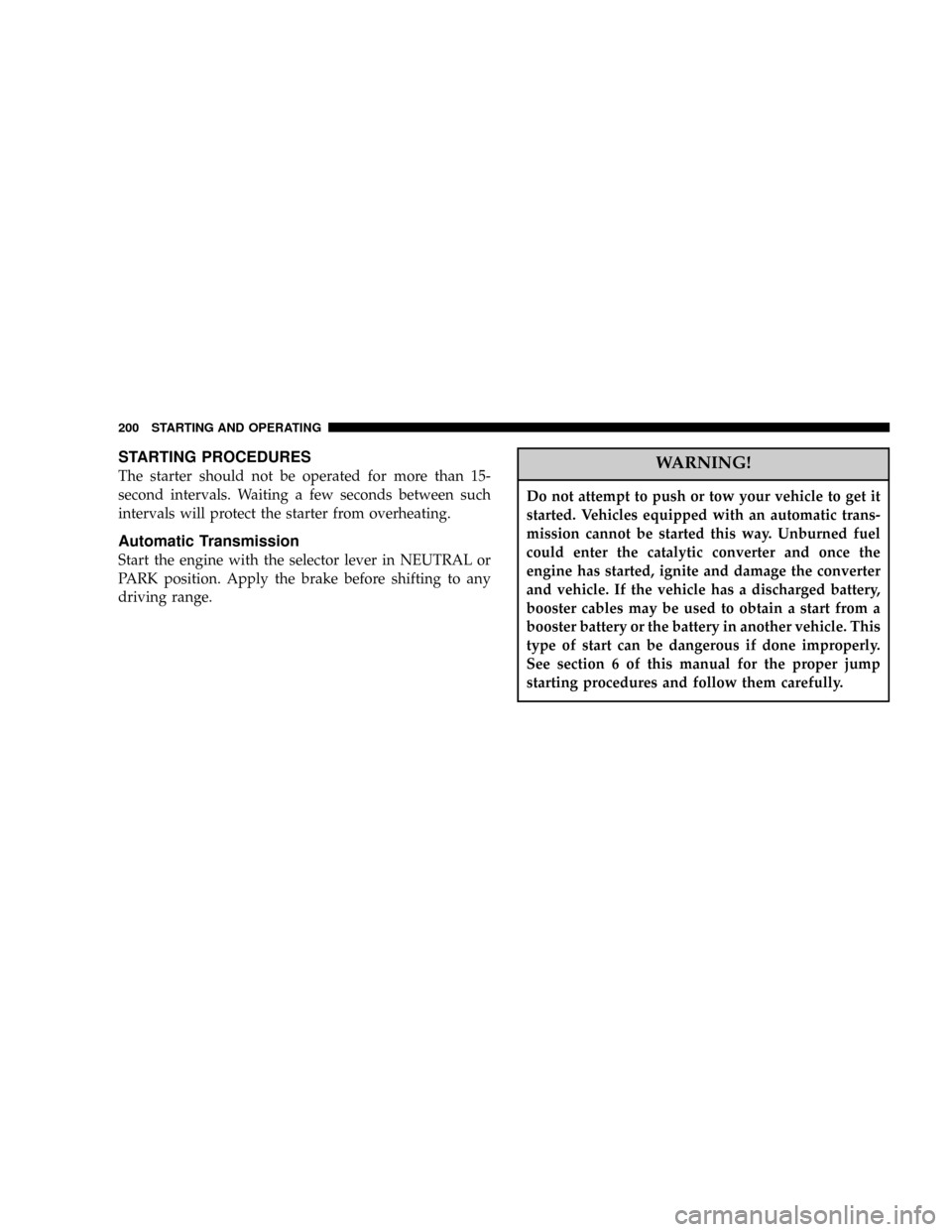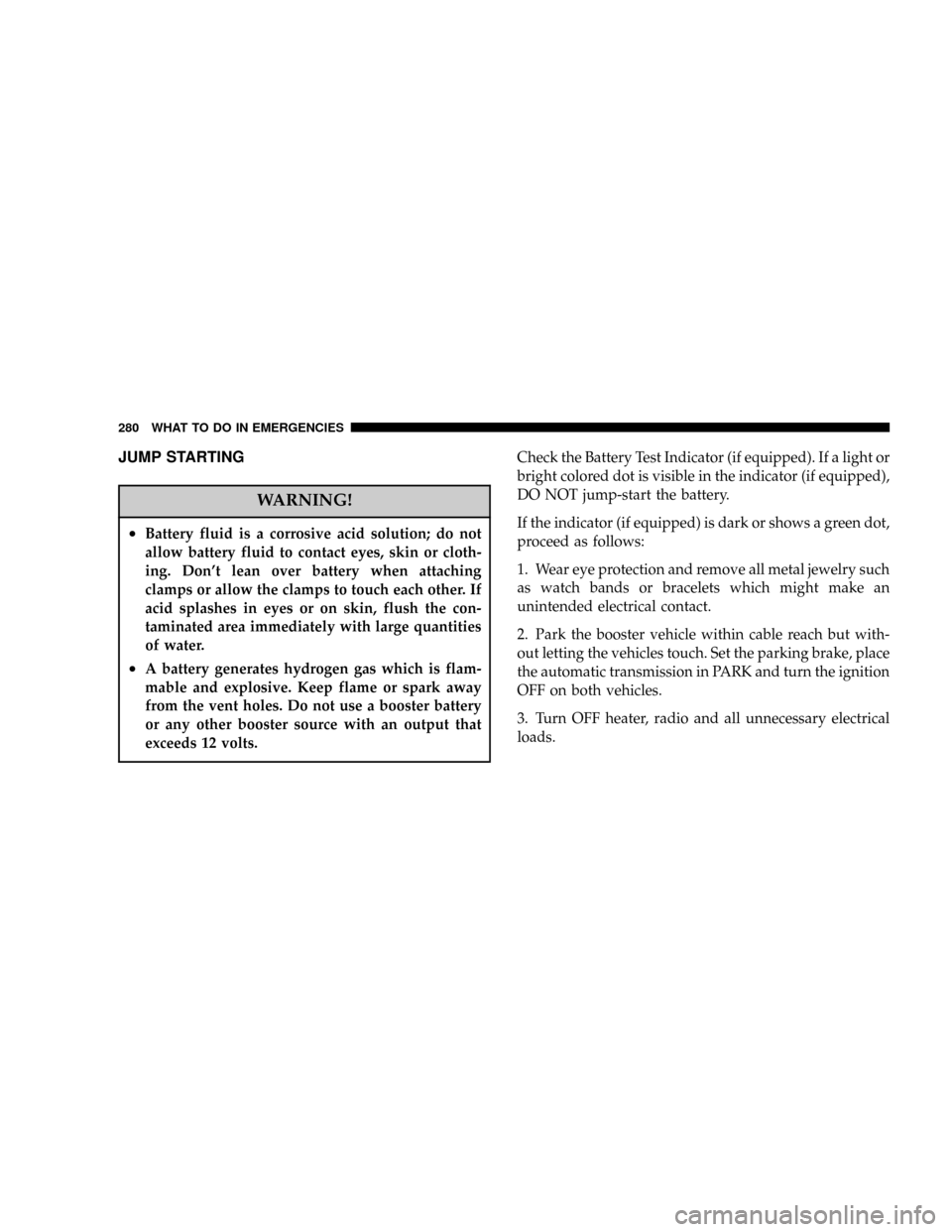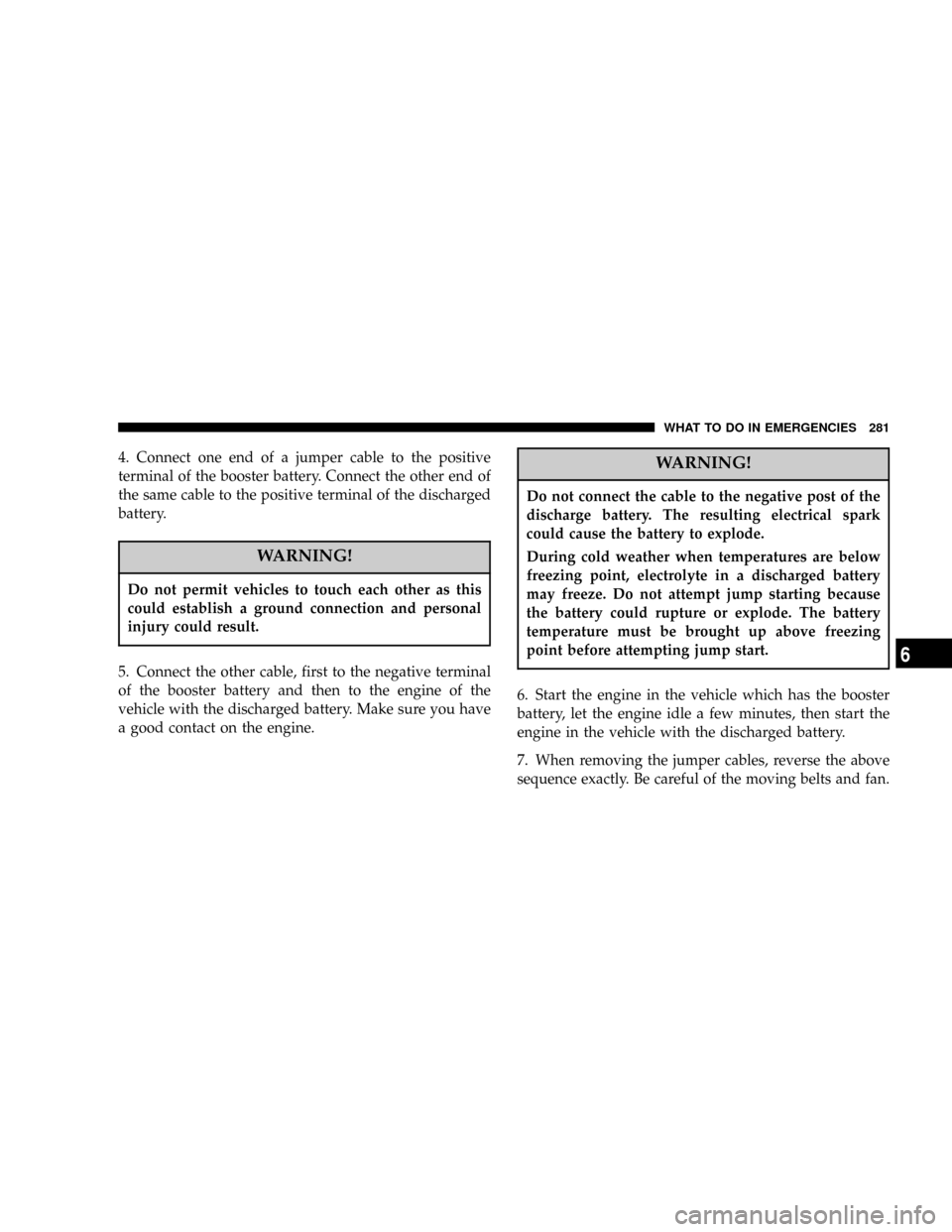jump start DODGE DURANGO 2004 2.G Owners Manual
[x] Cancel search | Manufacturer: DODGE, Model Year: 2004, Model line: DURANGO, Model: DODGE DURANGO 2004 2.GPages: 386, PDF Size: 6.22 MB
Page 200 of 386

STARTING PROCEDURES
The starter should not be operated for more than 15-
second intervals. Waiting a few seconds between such
intervals will protect the starter from overheating.
Automatic Transmission
Start the engine with the selector lever in NEUTRAL or
PARK position. Apply the brake before shifting to any
driving range.
WARNING!
Do not attempt to push or tow your vehicle to get it
started. Vehicles equipped with an automatic trans-
mission cannot be started this way. Unburned fuel
could enter the catalytic converter and once the
engine has started, ignite and damage the converter
and vehicle. If the vehicle has a discharged battery,
booster cables may be used to obtain a start from a
booster battery or the battery in another vehicle. This
type of start can be dangerous if done improperly.
See section 6 of this manual for the proper jump
starting procedures and follow them carefully.
200 STARTING AND OPERATING
Page 269 of 386

WHAT TO DO IN EMERGENCIES
CONTENTS
mHazard Warning Flasher..................270
mAdding Fuel..........................270
mChanging A Flat Tire....................272
NJack Location........................272
NRemoving The Spare Tire................273NTire Changing Procedure................275
mJump Starting.........................280
mTowing A Disabled Vehicle................282
NFour-Wheel Drive Vehicles...............282
NTwo-Wheel Drive Vehicles...............282
6
Page 280 of 386

JUMP STARTING
WARNING!
²Battery fluid is a corrosive acid solution; do not
allow battery fluid to contact eyes, skin or cloth-
ing. Don't lean over battery when attaching
clamps or allow the clamps to touch each other. If
acid splashes in eyes or on skin, flush the con-
taminated area immediately with large quantities
of water.
²A battery generates hydrogen gas which is flam-
mable and explosive. Keep flame or spark away
from the vent holes. Do not use a booster battery
or any other booster source with an output that
exceeds 12 volts.
Check the Battery Test Indicator (if equipped). If a light or
bright colored dot is visible in the indicator (if equipped),
DO NOT jump-start the battery.
If the indicator (if equipped) is dark or shows a green dot,
proceed as follows:
1. Wear eye protection and remove all metal jewelry such
as watch bands or bracelets which might make an
unintended electrical contact.
2. Park the booster vehicle within cable reach but with-
out letting the vehicles touch. Set the parking brake, place
the automatic transmission in PARK and turn the ignition
OFF on both vehicles.
3. Turn OFF heater, radio and all unnecessary electrical
loads.
280 WHAT TO DO IN EMERGENCIES
Page 281 of 386

4. Connect one end of a jumper cable to the positive
terminal of the booster battery. Connect the other end of
the same cable to the positive terminal of the discharged
battery.
WARNING!
Do not permit vehicles to touch each other as this
could establish a ground connection and personal
injury could result.
5. Connect the other cable, first to the negative terminal
of the booster battery and then to the engine of the
vehicle with the discharged battery. Make sure you have
a good contact on the engine.
WARNING!
Do not connect the cable to the negative post of the
discharge battery. The resulting electrical spark
could cause the battery to explode.
During cold weather when temperatures are below
freezing point, electrolyte in a discharged battery
may freeze. Do not attempt jump starting because
the battery could rupture or explode. The battery
temperature must be brought up above freezing
point before attempting jump start.
6. Start the engine in the vehicle which has the booster
battery, let the engine idle a few minutes, then start the
engine in the vehicle with the discharged battery.
7. When removing the jumper cables, reverse the above
sequence exactly. Be careful of the moving belts and fan.
WHAT TO DO IN EMERGENCIES 281
6
Page 374 of 386

Exhaust Gas Caution..................62,248
Fails to Start.......................... 201
Flooded, Starting...................... 201
Fuel Requirements..................... 335
Jump Starting......................... 280
Oil ...........................292,335,337
Oil Selection.......................... 335
Oil Synthetic......................... 296
Overheating.......................... 310
Starting............................. 200
Temperature Gauge..................... 146
Engine Oil Viscosity Chart................. 295
Entry System, Illuminated.................. 13
Equipment Identification Plate.............. 267
Ethylene Glycol Antifreeze................. 308
Exhaust Gas Caution................62,248,306
Exhaust System.......................62,306
Extender, Seat Belt........................ 37
Exterior Lighting........................ 106Filters
Air Cleaner.......................... 298
Engine Fuel.......................... 299
Engine Oil........................297,337
Engine Oil Disposal.................... 296
Flashers
Hazard Warning....................... 270
Turn Signal.....................108,146,329
Flat Tire Stowage.....................273,279
Flooded Engine Starting................... 201
Floor Console.......................... 137
Fluid, Brake........................... 338
Fluid Capacities......................... 335
Fluid Level Checks
Automatic Transmission................. 316
Brake............................... 313
Cooling System....................... 306
Engine Oil........................... 292
Power Steering........................ 303
374 INDEX
Page 383 of 386

Emergency (Jump Starting)............... 280
Engine Block Heater.................... 202
Engine Fails to Start.................... 201
Starting Procedures...................... 200
Steering
Column Controls...................... 108
Column Lock.......................... 12
Power...........................220,303
Wheel, Tilt........................... 113
Steering Wheel Mounted Sound System
Controls............................. 177
Storage, Vehicle......................... 326
Stuck, Freeing.......................... 221
Sun Roof.............................. 133
Supplemental Tire Pressure Information........ 239
Synthetic Engine Oil...................... 296
Tachometer............................ 149
Taillights.............................. 329Temperature Gauge, Engine Coolant.......... 146
Tether Anchor, Child Restraint............... 54
Theft System Arming...................... 25
Theft System Disarming.................... 25
Thermostat............................ 311
Tilt Steering Column..................... 113
Tire and Loading Information Placard......226,239
Tire Identification Number (TIN)............. 225
Tire Markings.......................... 221
Tire Safety Information.................... 221
Tires ...............................64,230
Air Pressure.......................... 230
Alignment........................... 238
Chains.............................. 239
Changing............................ 272
Compact Spare........................ 234
General Information.................... 230
High Speed.......................... 233
Inflation Pressures..................... 231
INDEX 383
10